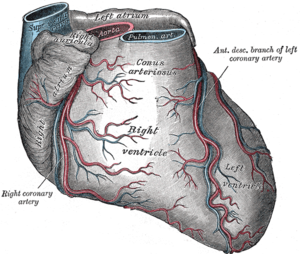 |
| Sternocostal surface of heart. (Right coronary artery visible at left.) (Photo credit: Wikipedia) |
The relation between coronary artery calcification in asymptomatic subjects and both traditional risk factors and living in the city centre: a DanRisk substudy (Abstract, J. Lambrechtsen, O. Gerke, K. Egstrup, N. P. Sand, B. L. Nørgaard, H. Petersen, H. Mickley, A. C. P. Diederichsen, Journal of Internal Medicine, Dec. 20,2011)
Also discussed here: Heart Study Suggests City Center Pollution Doubles Risk of Calcium Build-Up in Arteries (Science Daily, Apr. 26, 2012)
Today we review research that looked at the heart disease impacts for those living in city centres. Results indicate a much greater chance of heart disease there than in the suburbs or rural areas, especially with men.
Key Quotes:
"Our study aimed to evaluate the association between living in a city centre, which is often used by researchers to indicate exposure to air pollution, and the presence of coronary artery calcification in men and women showing no other symptoms of heart disease"
“The study also found that people who lived in city centres were 80% more likely to develop CAC [coronary artery calcification] than those living in other areas”
“rates were approximately three times higher in city centres than other urban areas and seven times higher than in rural areas.”
“Men were more than three times as likely as women to develop CAC, with a 220% higher odds risk.”
"The place where a person lives is often used as a surrogate for exposure to air pollution in research. In this study we found that, even after adjusting for demographic and clinical variables, where people lived was independently associated with CAC and that CAC levels were highest in people living in city centres”
Related articles
- Study suggests city center pollution doubles risk of calcium build-up in arteries (greencarcongress.com)
- Heart study suggests city center pollution doubles risk of calcium build-up in arteries (medicalxpress.com)
- More Coronary Artery Calcification With City Living (futurepundit.com)
- Heart study suggests city center pollution doubles risk of calcium build-up in arteries (eurekalert.org)
- Urban Living Increases Chances Of Heart Problems (eurasiareview.com)
- Coronary Heart Disease (socialsecurityhome.com)
- Women and risk of heart disease (jacksonville.com)
























